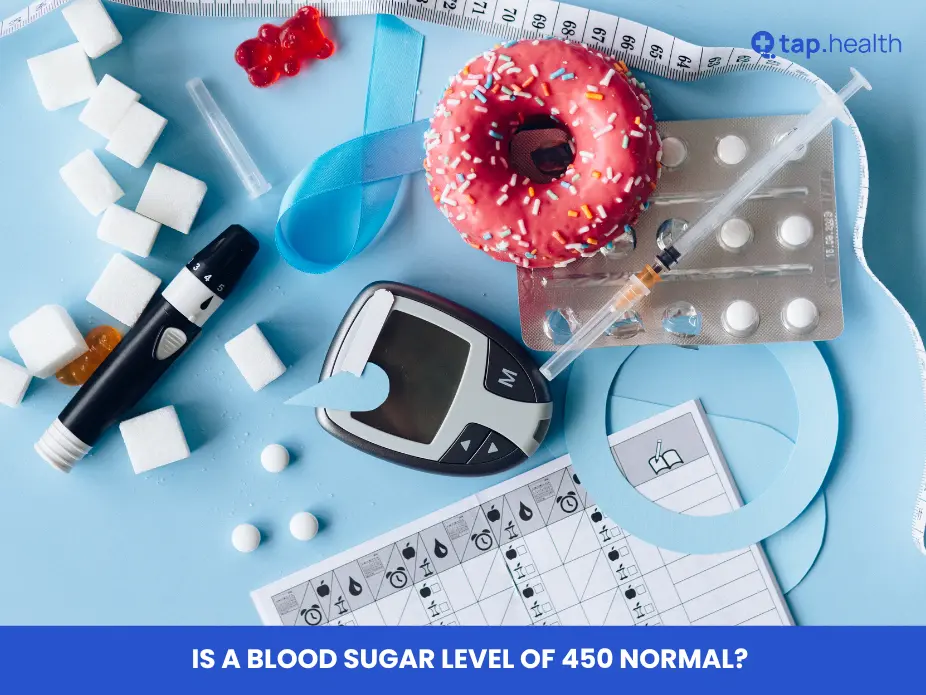Managing blood sugar levels is crucial for maintaining overall health, especially for individuals with diabetes. But what does a blood sugar level of 450 mean? Is it normal, or should you be concerned? In this article, we’ll explore what a blood sugar level of 450 signifies, the potential risks involved, and the steps you should take if you encounter such a high reading.
What is Blood Sugar?
Blood sugar, or blood glucose, is the main sugar found in your blood and your body’s primary source of energy. Your blood carries glucose to all your cells to use for energy. Insulin, a hormone produced by the pancreas, helps glucose enter your cells.
Understanding Blood Sugar Levels
Blood sugar levels are measured in milligrams per deciliter (mg/dL). Here’s a quick overview of what different levels mean:
- Normal Fasting Blood Sugar: 70-99 mg/dL
- Prediabetes: 100-125 mg/dL
- Diabetes: 126 mg/dL and above on two separate tests
After eating, blood sugar levels rise and typically return to normal within two hours. However, consistently high blood sugar levels can indicate diabetes or other health issues.
Is a Blood Sugar Level of 450 Normal?
A blood sugar level of 450 mg/dL is not normal. It is considered extremely high and requires immediate medical attention. Such a high level can lead to serious health complications, including:
- Diabetic Ketoacidosis (DKA): A condition where the body starts breaking down fats too quickly, leading to a buildup of acids called ketones in the blood.
- Hyperosmolar Hyperglycemic State (HHS): A serious condition characterized by very high blood sugar without significant ketone buildup.
- Organ Damage: Prolonged high blood sugar can damage organs like the heart, kidneys, and eyes.
Is a 450 Blood Sugar Level Dangerous?
Yes, a blood sugar level of 450 mg/dL is extremely dangerous. It signals that your body is unable to manage glucose effectively, which can result in life-threatening health complications if left untreated. High blood sugar levels require immediate attention to prevent both short-term and long-term health issues.
The Significance of a 450 Blood Sugar Reading
Immediate Risks of Blood Sugar Levels Around 450
When blood sugar levels reach 450 mg/dL, immediate risks include:
- Diabetic Ketoacidosis (DKA): A serious condition where the body starts breaking down fats at an excessive rate, leading to a buildup of acids called ketones in the blood. DKA can be life-threatening if not treated promptly.
- Hyperosmolar Hyperglycemic State (HHS): A condition characterized by very high blood sugar levels without the presence of ketones, leading to severe dehydration and confusion.
- Dehydration: High blood sugar causes increased urination, leading to significant loss of fluids and electrolytes.
- Severe Fatigue: The body cannot effectively use glucose for energy, resulting in extreme tiredness and weakness.
- Organ Damage: Prolonged high blood sugar can damage vital organs, including the heart, kidneys, and eyes.
Long-Term Health Implications
Consistently high blood sugar levels can lead to long-term complications such as:
- Cardiovascular Disease: Increased risk of heart attacks, strokes, and hypertension due to damage to blood vessels.
- Kidney Damage (Nephropathy): High glucose levels can damage the kidneys’ filtering system, potentially leading to kidney failure.
- Nerve Damage (Neuropathy): Excess sugar can injure nerves throughout the body, causing pain, tingling, or numbness, particularly in the extremities.
- Eye Problems (Retinopathy): Elevated blood sugar can lead to retinopathy, increasing the risk of blindness.
- Foot Problems: Poor circulation and nerve damage can lead to serious foot infections and, in severe cases, amputations.
- Skin Conditions: High blood sugar can make the skin more susceptible to bacterial and fungal infections.
- Dental Issues: Increased risk of gum disease and other oral health problems due to poor blood sugar control.
- Mental Health Issues: Chronic high blood sugar can contribute to depression, anxiety, and other mental health challenges.
Causes of Extremely High Blood Sugar
Several factors can cause blood sugar levels to soar to 450 mg/dL:
- Type 1 Diabetes: The body doesn’t produce insulin, leading to high blood sugar.
- Type 2 Diabetes: The body becomes resistant to insulin or doesn’t produce enough.
- Insufficient Insulin or Medication: Missing doses or incorrect medication can spike blood sugar.
- Infections or Illness: Stress from illness can increase blood sugar levels.
- Certain Medications: Some drugs can raise blood sugar levels.
- Stress: Physical or emotional stress can trigger the release of hormones that increase blood sugar.
- Dietary Choices: Consuming high-carbohydrate or sugary foods can lead to elevated blood sugar levels.
Symptoms of Extremely High Blood Sugar
Recognizing the symptoms of high blood sugar is crucial for timely intervention. Common symptoms include:
- Frequent Urination: The body tries to eliminate excess glucose through urine.
- Extreme Thirst: Loss of fluids leads to dehydration.
- Fatigue: Cells aren’t getting the energy they need.
- Blurred Vision: High glucose levels can affect the lenses in your eyes.
- Nausea and Vomiting: Often associated with DKA or HHS.
- Shortness of Breath: Can be a sign of DKA.
- Confusion or Difficulty Concentrating: High levels affect brain function.
- Dry Mouth and Skin: Dehydration can cause dryness.
- Rapid Heartbeat: The body may try to compensate for fluid loss.
- Unexplained Weight Loss: The body may break down fat and muscle for energy.
Risks of Ignoring High Blood Sugar
Ignoring a blood sugar level of 450 mg/dL can lead to severe health issues:
- Diabetic Ketoacidosis (DKA): Can be life-threatening if not treated promptly.
- Hyperosmolar Hyperglycemic State (HHS): Also potentially fatal if untreated.
- Long-term Complications: Including heart disease, kidney damage, neuropathy, and vision problems.
- Increased Risk of Infections: High blood sugar can weaken the immune system.
- Circulatory Problems: Leading to poor wound healing and increased risk of amputations.
What to Do If Your Blood Sugar Is 450
If you or someone you know has a blood sugar level of 450 mg/dL, take the following steps immediately:
- Seek Medical Help: Contact your healthcare provider or go to the emergency room.
- Check for Ketones: Use a ketone test strip to determine if you have ketones in your urine.
- Stay Hydrated: Drink water to help lower blood sugar levels, unless advised otherwise by a healthcare professional.
- Follow Your Treatment Plan: Take your insulin or diabetes medications as prescribed.
- Avoid High-Carb Foods: Focus on balanced meals to prevent further spikes.
- Rest: Physical activity can sometimes help lower blood sugar, but only do so if advised by a healthcare provider.
- Monitor Symptoms: Keep an eye on any new or worsening symptoms and report them to your doctor.
How Bad is a 450 Blood Sugar Level?
A blood sugar level of 450 mg/dL is considered extremely bad and poses significant health risks. It requires immediate attention to prevent acute complications such as diabetic ketoacidosis (DKA) and hyperosmolar hyperglycemic state (HHS), as well as long-term health issues like cardiovascular disease and nerve damage. Consistently high blood sugar levels can severely impact your quality of life and overall health, making it crucial to manage and lower these levels effectively.
Are There Any Lifestyle Changes That Can Help Manage a Blood Sugar Level of 450?
Yes, several lifestyle changes can help manage and reduce a blood sugar level of 450 mg/dL:
- Adopt a Balanced Diet: Incorporate more vegetables, whole grains, and lean proteins while reducing sugar and refined carbohydrates. Consider consulting a nutritionist for a personalized meal plan.
- Increase Physical Activity: Regular exercise helps improve insulin sensitivity and lowers blood sugar levels. Even light activities like walking can make a difference.
- Monitor Blood Sugar Levels: Regular monitoring helps track progress and adjust treatments as needed. Use a reliable glucose meter and keep a log of your readings.
- Stay Hydrated: Drinking plenty of water helps your kidneys flush out excess glucose. Aim for at least 8 glasses of water a day.
- Avoid Smoking and Limit Alcohol: Both smoking and excessive alcohol intake can negatively impact blood sugar control and overall health.
- Manage Stress: Stress can increase blood sugar levels. Practice stress-reducing techniques like meditation, yoga, or deep-breathing exercises.
- Get Adequate Sleep: Aim for 7-9 hours of quality sleep each night to help regulate hormones that affect blood sugar.
- Consistent Medication Adherence: Take prescribed medications or insulin as directed by your healthcare provider without missing doses.
What Are the Long-Term Effects of Consistently Having a Blood Sugar Level of 450?
Consistently high blood sugar levels can lead to severe long-term health complications, including:
- Cardiovascular Disease: High blood sugar can damage blood vessels, increasing the risk of heart attacks, strokes, and hypertension.
- Kidney Failure (Nephropathy): Prolonged hyperglycemia can damage the kidneys’ filtering system, leading to chronic kidney disease or kidney failure.
- Nerve Damage (Neuropathy): Excess sugar can injure nerves throughout the body, causing pain, tingling, numbness, or weakness, especially in the hands and feet.
- Vision Loss (Retinopathy): High blood sugar can damage the blood vessels in the retina, leading to vision problems and even blindness.
- Foot Problems: Poor circulation and nerve damage can lead to serious foot infections, ulcers, and in severe cases, amputations.
- Skin Conditions: High blood sugar can make the skin more susceptible to bacterial and fungal infections.
- Dental Issues: Increased risk of gum disease and other oral health problems due to poor blood sugar control.
- Mental Health Issues: Chronic high blood sugar can contribute to depression, anxiety, and other mental health challenges.
- Gastrointestinal Problems: High blood sugar can affect the digestive system, leading to issues like gastroparesis (delayed stomach emptying).
- Sexual Dysfunction: Nerve damage and poor circulation can lead to sexual health issues, such as erectile dysfunction in men and decreased libido in women.
These complications not only affect physical health but can also significantly impact emotional and mental well-being, highlighting the importance of maintaining healthy blood sugar levels.
How Do You Lower a Blood Sugar of 450?
Lowering a blood sugar level of 450 mg/dL involves a combination of immediate actions and long-term strategies:
- Take Prescribed Medications: Follow your healthcare provider’s instructions regarding insulin or other medications. Do not adjust your dosage without consulting your doctor.
- Hydrate: Drink plenty of water to help flush out excess glucose through urine. Staying hydrated is essential for managing high blood sugar.
- Exercise: Engage in light physical activity, such as walking or stretching. Physical activity helps your body use insulin more effectively, but avoid strenuous exercise if you are very high.
- Monitor Blood Sugar: Keep track of your blood sugar levels to ensure they are coming down. Regular monitoring helps in adjusting treatments as needed.
- Follow a Healthy Diet: Avoid sugary foods and refined carbohydrates. Focus on low-carb, high-fiber foods that can help stabilize blood sugar levels.
- Seek Medical Advice: If your blood sugar remains high despite these measures, contact your healthcare provider for further guidance.
How Do You Treat Blood Sugar of 450?
Treating a blood sugar level of 450 mg/dL typically involves:
- Insulin Administration: Rapid-acting insulin may be necessary to bring levels down quickly. Your healthcare provider will determine the appropriate dosage based on your specific needs.
- Hydration Therapy: Intravenous fluids may be required in severe cases to address dehydration and help lower blood sugar levels.
- Electrolyte Replacement: Balancing electrolytes if there is significant loss through urine is crucial for preventing complications.
- Medical Supervision: Continuous monitoring in a healthcare setting ensures safe and effective reduction of blood sugar levels and management of any complications.
- Addressing Underlying Causes: Identifying and treating any underlying issues, such as infection or illness, that may be contributing to high blood sugar levels.
Immediate medical intervention is essential to prevent life-threatening complications and stabilize your condition.
Preventing Extremely High Blood Sugar Levels
Preventing such high blood sugar levels involves consistent management of diabetes:
- Regular Monitoring: Check your blood sugar levels frequently as advised by your doctor.
- Medication Adherence: Take insulin or other diabetes medications as prescribed.
- Healthy Diet: Focus on a balanced diet rich in vegetables, lean proteins, and whole grains.
- Regular Exercise: Helps improve insulin sensitivity and control blood sugar levels.
- Manage Stress: Stress can affect blood sugar levels, so find healthy ways to cope.
- Regular Check-ups: Visit your healthcare provider regularly to monitor your condition.
- Educate Yourself: Understand how different foods and activities affect your blood sugar.
- Avoid Skipping Meals: Regular eating patterns help maintain stable blood sugar levels.
- Limit Alcohol Consumption: Alcohol can affect blood sugar levels and interact with medications.
When to Consult a Doctor
You should consult a healthcare professional if you experience:
- Blood sugar levels consistently above 300 mg/dL
- Symptoms of DKA or HHS, such as confusion, vomiting, or difficulty breathing
- Any significant changes in your blood sugar control
- Unexplained weight loss
- Persistent fatigue despite adequate rest
- Recurrent infections or slow-healing wounds
Managing Blood Sugar Levels Effectively
Effective management of blood sugar levels is essential to prevent both acute and long-term complications. Here are some strategies to help you manage your blood sugar effectively:
Balanced Diet
Eating a balanced diet helps regulate blood sugar levels. Focus on:
- Complex Carbohydrates: Whole grains, vegetables, and legumes provide steady energy.
- Lean Proteins: Chicken, fish, tofu, and beans help maintain muscle mass.
- Healthy Fats: Avocados, nuts, and olive oil support overall health.
- Fiber-Rich Foods: Fiber slows the absorption of sugar, preventing spikes.
Regular Physical Activity
Exercise helps your body use insulin more efficiently. Aim for:
- Aerobic Exercise: Such as walking, cycling, or swimming for at least 150 minutes per week.
- Strength Training: Building muscle mass improves insulin sensitivity.
- Flexibility Exercises: Yoga or stretching can reduce stress levels.
Medication Management
Proper use of medications is crucial:
- Insulin Therapy: For those with Type 1 diabetes or advanced Type 2 diabetes.
- Oral Medications: Such as metformin, which helps control blood sugar levels.
- Continuous Glucose Monitoring (CGM): Provides real-time blood sugar levels for better management.
Stress Management
Chronic stress can lead to elevated blood sugar levels. Techniques to manage stress include:
- Mindfulness Meditation: Reduces stress and improves mental clarity.
- Deep Breathing Exercises: Helps calm the nervous system.
- Hobbies and Leisure Activities: Engage in activities you enjoy to take your mind off stressors.
Education and Support
Understanding diabetes and having a support system can make management easier:
- Diabetes Education Programs: Offer knowledge and skills to manage the condition effectively.
- Support Groups: Connecting with others who have diabetes can provide emotional support.
- Healthcare Team: Regular communication with your doctor, dietitian, and diabetes educator ensures comprehensive care.
The Importance of Early Detection
Early detection of high blood sugar levels can prevent complications. Regular screenings and blood tests are essential, especially if you have risk factors for diabetes, such as:
- Family History: A family history of diabetes increases your risk.
- Overweight or Obesity: Excess weight can lead to insulin resistance.
- Sedentary Lifestyle: Lack of physical activity contributes to high blood sugar.
- Age: The risk of Type 2 diabetes increases with age.
- Ethnicity: Certain ethnic groups are at higher risk for diabetes.
Technological Advances in Blood Sugar Management
Advancements in technology have made managing blood sugar levels more accessible and effective:
- Continuous Glucose Monitors (CGMs): Provide real-time blood sugar readings, allowing for timely adjustments.
- Insulin Pumps: Deliver a steady stream of insulin, reducing the need for multiple injections.
- Mobile Apps: Help track blood sugar levels, diet, and exercise, providing insights for better management.
- Telemedicine: Offers remote consultations with healthcare providers, making it easier to manage diabetes.
Lifestyle Changes to Maintain Healthy Blood Sugar Levels
Incorporating lifestyle changes can significantly impact your blood sugar management:
- Healthy Eating Habits: Plan meals with a balance of carbohydrates, proteins, and fats.
- Regular Exercise Routine: Find activities you enjoy to stay motivated.
- Adequate Sleep: Aim for 7-9 hours of quality sleep per night to support overall health.
- Avoid Smoking: Smoking increases the risk of diabetes complications.
- Limit Sugar Intake: Reduce consumption of sugary beverages and snacks.
The Role of Hydration in Blood Sugar Control
Staying hydrated is essential for maintaining healthy blood sugar levels:
- Water Intake: Helps flush excess glucose from the bloodstream through urine.
- Avoid Sugary Drinks: Opt for water, herbal teas, or other non-sugary beverages.
- Monitor Fluid Balance: Especially important if you’re experiencing symptoms like excessive thirst or frequent urination.
Understanding the Psychological Impact of High Blood Sugar
Managing diabetes and high blood sugar levels can take a toll on mental health:
- Stress and Anxiety: Worrying about blood sugar levels and health can lead to anxiety.
- Depression: The burden of managing a chronic condition may contribute to depression.
- Coping Strategies: Seek professional help, practice mindfulness, and stay connected with supportive individuals.
Frequently Asked Questions (FAQ) on Is a Blood Sugar Level of 450 Normal?
1. Can a blood sugar level of 450 mg/dL be reversed at home?
A blood sugar level of 450 mg/dL is dangerously high and typically requires medical intervention. While staying hydrated and taking prescribed medications can help lower blood sugar, it’s essential to seek medical assistance immediately to prevent complications like DKA or HHS.
2. What are the immediate dangers of having a blood sugar level of 450?
Immediate dangers include diabetic ketoacidosis (DKA), hyperosmolar hyperglycemic state (HHS), organ damage, severe dehydration, and potential life-threatening complications. Prompt medical attention is crucial to manage these risks.
3. How long does it take for blood sugar to return to normal after reaching 450 mg/dL?
The time it takes to return to normal varies depending on the individual and the effectiveness of treatment. With appropriate medical intervention, blood sugar levels can begin to stabilize within hours, but it may take days to fully return to normal levels.
4. Can certain foods cause blood sugar to spike to 450 mg/dL?
While it’s rare for a single meal to cause blood sugar to spike to 450 mg/dL, consuming large amounts of high-carbohydrate or sugary foods can significantly raise blood sugar levels, especially in individuals with diabetes who have difficulty managing their insulin levels.
5. Is a blood sugar level of 450 mg/dL more common in Type 1 or Type 2 diabetes?
Extremely high blood sugar levels like 450 mg/dL can occur in both Type 1 and Type 2 diabetes. However, they are more commonly associated with Type 1 diabetes due to the absolute deficiency of insulin. In Type 2 diabetes, such high levels are less common but can occur under severe insulin resistance or insufficient medication management.
6. What lifestyle changes can help prevent blood sugar from reaching 450 mg/dL?
Lifestyle changes that can help include maintaining a balanced diet, regular physical activity, adhering to medication schedules, managing stress, avoiding excessive alcohol consumption, not smoking, and regularly monitoring blood sugar levels.
7. Can stress cause blood sugar levels to rise to 450 mg/dL?
Yes, severe stress, whether physical or emotional, can cause a significant increase in blood sugar levels due to the release of stress hormones like cortisol and adrenaline, which promote glucose production.
8. How often should I check my blood sugar to prevent such high levels?
The frequency of blood sugar monitoring depends on your type of diabetes and treatment plan. Typically, individuals with Type 1 diabetes may need to check multiple times a day, while those with Type 2 diabetes may check less frequently. Consult your healthcare provider for a monitoring schedule tailored to your needs.
9. Are there any medications that can help lower blood sugar quickly?
Yes, insulin therapy is the most effective way to lower blood sugar quickly. Other medications, such as rapid-acting insulin analogs, can also help reduce blood sugar levels. Always follow your healthcare provider’s instructions regarding medication use.
10. What should I do if I experience symptoms of extremely high blood sugar?
If you experience symptoms of extremely high blood sugar, such as confusion, vomiting, or difficulty breathing, seek emergency medical attention immediately. Do not delay, as these symptoms can indicate life-threatening conditions like DKA or HHS.
Conclusion
A blood sugar level of 450 mg/dL is extremely high and not normal. It poses serious health risks and requires immediate medical attention. Managing blood sugar levels through proper medication, diet, exercise, and regular monitoring is essential to prevent such dangerous spikes. Always consult with your healthcare provider to tailor a diabetes management plan that works best for you.
References
- American Diabetes Association
- Mayo Clinic: High blood sugar (hyperglycemia)
- Centers for Disease Control and Prevention (CDC): Hyperglycemia
- National Institute of Diabetes and Digestive and Kidney Diseases (NIDDK)
- Harvard Health Publishing: Understanding Diabetes and Blood Sugar
- National Diabetes Information Clearinghouse



